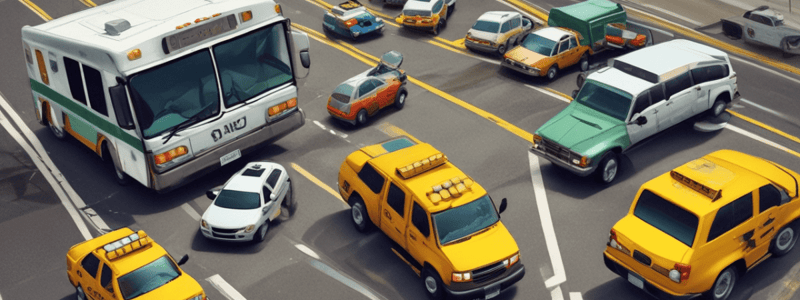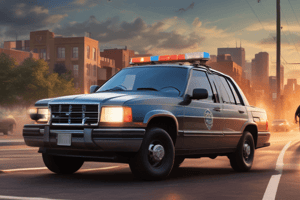Podcast
Questions and Answers
What is the primary goal of an officer responding to an emergency?
What is the primary goal of an officer responding to an emergency?
- To manage traffic density
- To select the safest route
- To ensure a prompt arrival (correct)
- To avoid traffic congestion
What type of traffic pattern should an officer avoid?
What type of traffic pattern should an officer avoid?
- Regular traffic flow
- Cooperative traffic
- Uncooperative traffic (correct)
- Fast moving traffic
Why should an officer avoid school zones?
Why should an officer avoid school zones?
- Because of heavy pedestrian traffic (correct)
- Because of construction zones
- Because of slow moving vehicles
- Because of one-way streets
What is a disadvantage of using one-way streets?
What is a disadvantage of using one-way streets?
What should an officer consider when selecting a route?
What should an officer consider when selecting a route?
Why is it important to avoid roads with poor visibility at intersections?
Why is it important to avoid roads with poor visibility at intersections?
Why are headlights used in conjunction with emergency overhead lights during the day?
Why are headlights used in conjunction with emergency overhead lights during the day?
What is the effect of fog on emergency lights?
What is the effect of fog on emergency lights?
Why are sirens often required by statute, regardless of the time of day?
Why are sirens often required by statute, regardless of the time of day?
What is the effect of large vehicles on siren audibility?
What is the effect of large vehicles on siren audibility?
Why are pedestrians often not adequately warned by emergency lights?
Why are pedestrians often not adequately warned by emergency lights?
What is the preferred response in areas with high pedestrian traffic?
What is the preferred response in areas with high pedestrian traffic?
Flashcards are hidden until you start studying
Study Notes
Route Selection Factors for Emergency Response
- Avoid roads with heavy or uncooperative traffic patterns, such as commercially zoned areas
- Avoid areas with slow-moving or large vehicles, such as tractor-trailers or farm equipment
- Avoid areas with heavy pedestrian traffic, such as school zones, busy intersections, bus loading and unloading zones, and parked cars
- Avoid slow-moving traffic conditions, such as construction zones, special entertainment events, bumper-to-bumper traffic, and rough pavement roads or roads that have potholes, multiple bumps, and non-paved surfaces
- Select roads with acceptable line-of-sight conditions, avoiding roads with hills and curves, poor visibility at intersections, or poor visibility due to parked vehicles
- Consider one-way streets, which offer the advantage of avoiding oncoming traffic but the disadvantage of approaching all vehicles from the rear
Emergency Warning Devices on Enforcement Vehicles
- Emergency warning devices, such as headlights, emergency flasher lights, and sirens, enhance the officer's ability to maneuver in traffic and reduce the risk to self and others
- Headlights are more discernible than traditional red or blue overheads in the daytime
- Emergency flasher lights are helpful in daylight
- Sirens are often required by statute, regardless of the time of day, when engaged in emergency driving
- Emergency lights and sirens are not a substitute for caution and utilization of mastered driving skills
Factors Affecting Siren Audibility and Light Visibility
- Weather conditions:
- Overcast or cloudy days: sirens are heard sooner
- Clear days: siren audibility dissipates into the atmosphere
- Fog: sound carries through moisture with minimal loss of decibels at close range, but dissipates at greater distances
- Inclement weather: reduces the value of lights and sirens, making driving skills critical
- Vehicular traffic conditions:
- Increasing traffic noise reduces siren audibility
- Large vehicles, such as heavy trucks and buses, decrease the effectiveness of sirens
- Location:
- Residential areas: sirens are less discernible
- Large trees and hedges absorb sound, reducing siren effectiveness
- Tall buildings block, deflect, or tunnel sound transmission, reducing siren value
- Flat open areas: sirens can be heard at a greater distance
- Pedestrian traffic conditions:
- Emergency lights may not adequately warn pedestrians
- Sirens offer greater warning to pedestrian traffic
- Great care and caution must be taken in areas congested with foot traffic
- Speed control is the preferred response in areas with pedestrian traffic
Studying That Suits You
Use AI to generate personalized quizzes and flashcards to suit your learning preferences.




